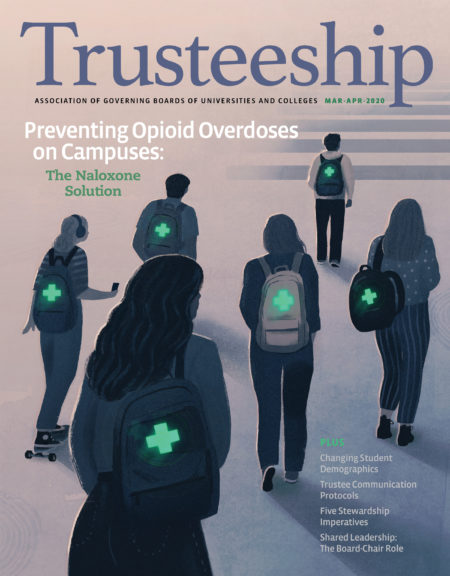
As higher education faces ever-changing challenges today reflecting news headlines such as opioids, sexual misconduct on campus, undue political influence, workforce preparation, college closures, and enrollment declines, overseeing risks has become an increased priority for governing boards seeking to drive student success, institutional vitality, and long-term favorable reputations.
Risk oversight rises to the top of many board agendas as an issue boards must con-front as trustees are more concerned than ever about the future of higher education. The AGB 2020 Trustee Index revealed that while trustees believe that their institution is “prepared” or “very prepared” to meet today’s most challenging issues, their concern about the future of the higher education sector over the next decade increased by 12 percentage points—from 73 percent in 2018 to 85 percent in 2019! Trustees’ concern is due to a host of factors, including financial sustainability, the price of education, public perception, and decreases in state funding. And more than half of all board members expressed concern about a major risk—the financial stability of their institution.
The good news is that forward-thinking boards can help higher education navigate through these turbulent seas. Risk oversight is one of your most important roles, and your commitment to mitigating risks that could impact an institution’s long-term reputation is essential. To effectively oversee the affairs of your institution or foundation, board members must remember the “noses in and fingers out ” (also known as NIFO) approach when it comes to governance. The board’s role is to oversee—not manage—the execution of strategies and policy development to mitigate risks. While risk oversight and enterprise risk management are complex topics, this effort can be summarized in three phases: protect, respond, and recover.
1. Protect: Boards should establish roles and responsibilities necessary to collaboratively identify and prioritize risks with the executive team and establish policies and barriers to protect against prioritized risks. Risk will differ across institutions. For example, an institution that has significant donor funding may prioritize risk in that area, while institutions that have robust athletic recruitment for admissions may have greater risk in that area. Further, despite boards’ best efforts, risks such as cyber, campus protests, sexual misconduct, and undue political influence may unfortunately occur. It is important that boards establish their risk appetite and prioritize the likelihood of risks occurring at their specific institution.
2. Respond: Boards should oversee the development of a written plan on how to respond to a crisis. A written crisis response plan is undoubtedly one of the most necessary components of an enterprise risk management strategy, and the development of the crisis response plan should include a wide range of stakeholders. Additionally, boards, presidents, and cabinet members should collaboratively rehearse various scenarios via table-top exercises because no plan on paper is effective unless it is rehearsed in advance.
3. Recover: Recovery from a crisis may take extended periods of time and should include all relevant stakeholders. After-action reports are a proven method to document lessons learned regarding how the board, cabinet, and stakeholders, including local law enforcement and even perhaps the FBI, responded to the crisis. This can help foster a good working relationship with key officials who could be involved in managing a future crisis.
Elevating your commitment to overseeing risks facing your institutions and foundations and establishing more robust risk mitigation and preparedness practices is crucial, especially in the modern-day higher education environment.
This month AGB will publish the second edition of Risk Management: An Accountability Guide for University and College Boards, written by seasoned trustee Janice M. Abraham. Abraham notes in the new edition that much has changed in the last seven years. The risks that higher education confronts are now more complex, and the strategies for managing them have necessarily evolved—to such an extent that we now recognize the benefits of risk. The most successful organizations, she notes, are optimizing risk to achieve goals. In April, AGB is releasing Crisis Leadership for Boards and Presidents: Anticipating, Managing, and Leading Beyond, which offers advice on how to anticipate crises before they occur, how to prepare for the unavoidable ones, and how to navigate crises.
I urge you to familiarize yourself with these new AGB’s new resources. It is AGB’s mission to help board members govern with confidence in this fast-moving higher education sector. Raising risk management to the highest level of strategic leadership can help ensure that your institution stays ahead of any crises that may come your way.

